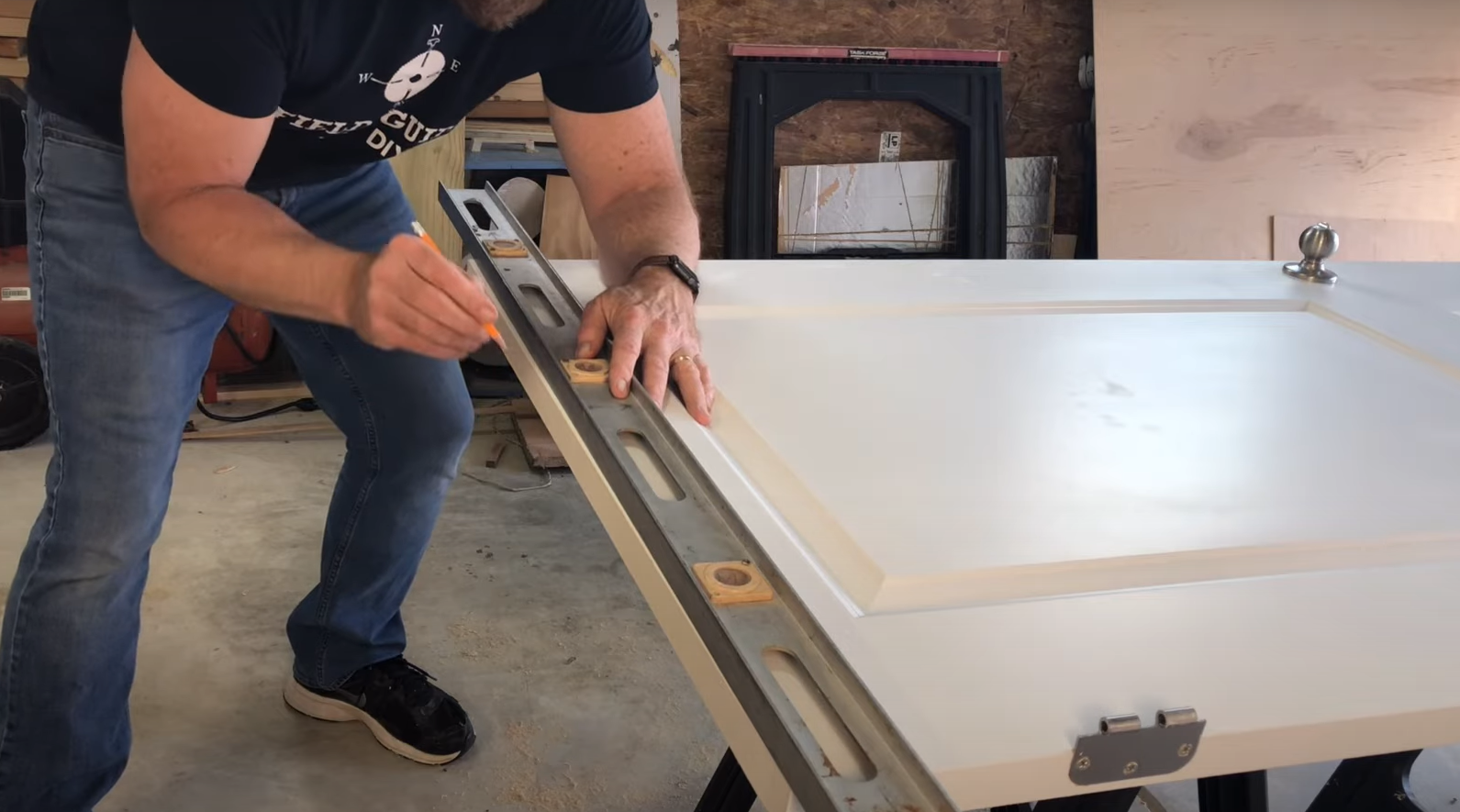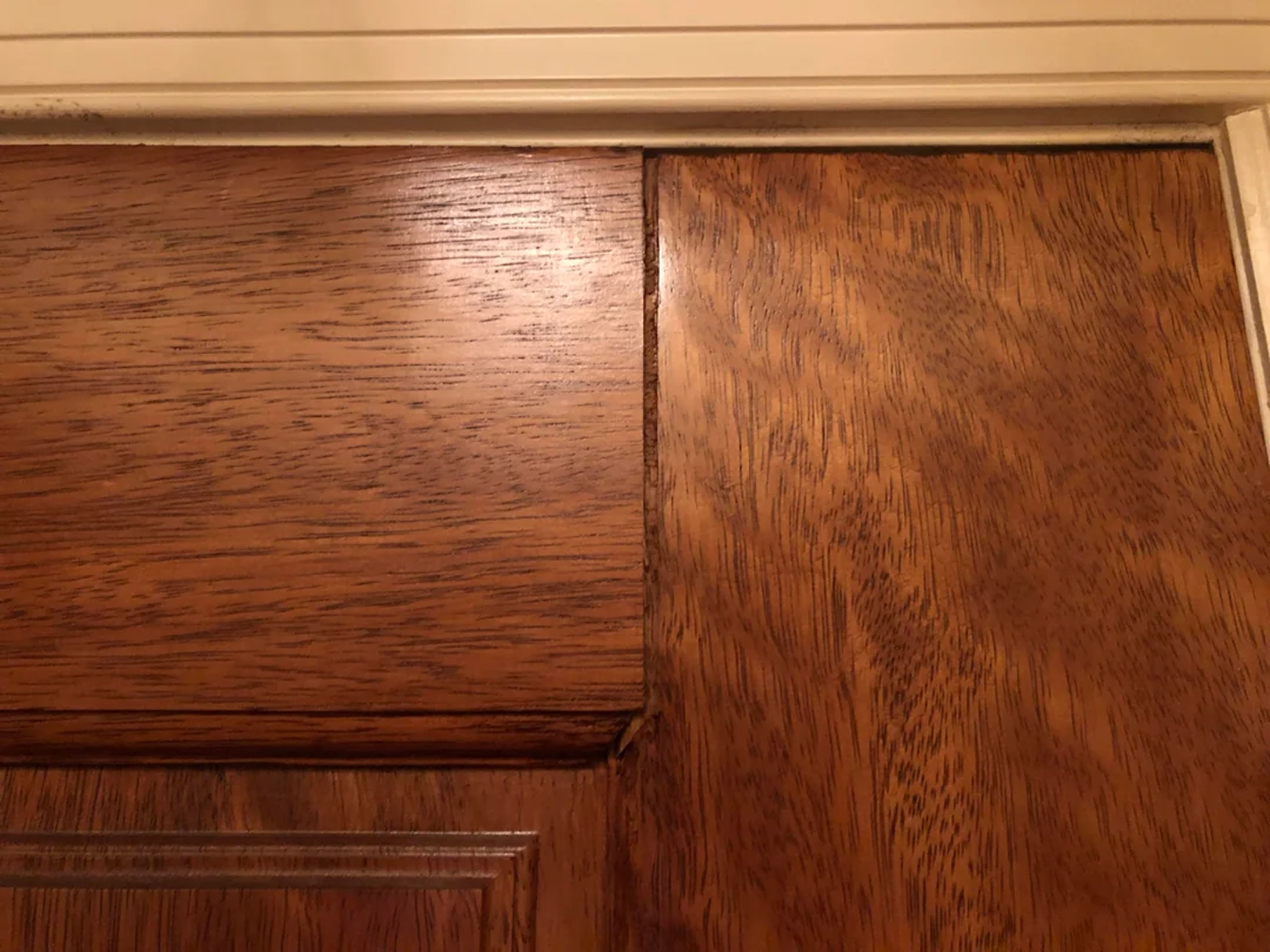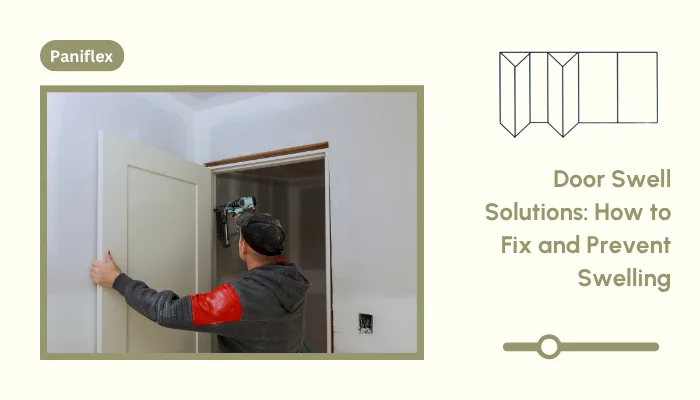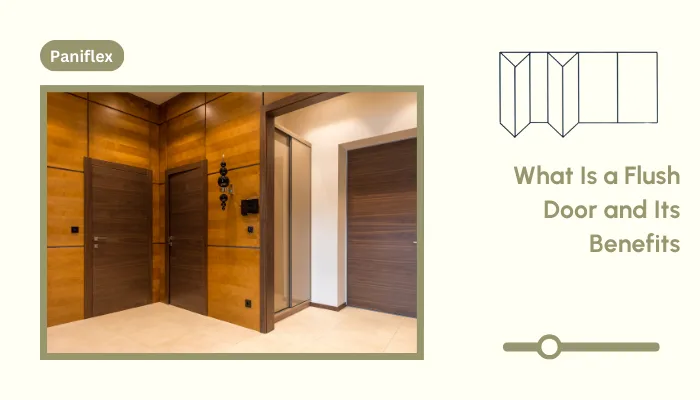Door swelling is a common issue in residential and commercial projects. Humidity, moisture, and poor materials often cause warping and sticking. We know how frustrating it is when doors fail despite proper planning and installation. It leads to delays, callbacks, and dissatisfied clients.
This guide explains why doors swell, how to fix existing problems, and how to prevent future issues with smarter material and design choices.
Ready to experience the benefits of custom closet doors? Explore our range of Paniflex products now.
TL;DR
- Fix door swelling by sanding the swollen areas, adjusting the hardware, and sealing the edges to prevent future moisture absorption.
- Door swelling is caused by humidity, poor sealing, substandard materials, and installation errors.
- Prevent swelling by specifying moisture-resistant materials, applying factory finishes, and following proper installation practices.
- Solid backing and high-quality hardware reduce warping, sticking, and alignment issues in high-humidity environments.
Understanding Door Swelling and Its Impact on Projects
Door swelling occurs when a door absorbs moisture from the surrounding air. This moisture causes the door to expand, making it difficult to open, close, or align within its frame. The problem is most noticeable in humid environments, but it can affect any project if the right materials and finishes are not specified.
Swelling compromises both functionality and design. Sticking doors frustrate end users, while warped panels disrupt clean lines and precise fits in interior designs. For professionals, these issues can lead to costly site visits, rework, and even replacement, affecting project schedules and budgets.
Understanding why doors swell is the first step in preventing these challenges and delivering long-lasting, high-quality installations.
What Causes Door Swelling?
Door swelling happens when the door absorbs moisture from the air or surroundings. This causes the material to expand, warp, and stick in the frame.
It is common in humid climates, poorly ventilated spaces, or where inferior materials were used. Understanding the causes helps prevent long-term damage and client complaints.
- Humidity and Moisture Exposure: Wood and MDF absorb moisture from the air. Seasonal humidity changes lead to expansion and contraction, creating alignment and closure issues.
- Poor Sealing and Finishing: Unsealed edges allow moisture to penetrate the door core, compromising its integrity. Inadequate or uneven finishing can accelerate swelling in kitchens and bathrooms.
- Installation Errors: Improper clearances, lack of acclimatization, or substandard hardware can trap doors in their frames when they expand. These mistakes increase the risk of swelling significantly.
- Substandard Door Materials: Low-quality or poorly engineered doors lack moisture resistance. Hollow-core doors and certain low-density composites are more prone to absorbing moisture.
- Improper Storage Before Installation: Doors stored on damp floors or in unconditioned spaces absorb moisture even before installation. Failing to acclimate them to site conditions can lead to immediate swelling once installed.
Knowing the causes is the first step in fixing doors that won’t close. The next step is to find the right tools and materials to fix swollen doors effectively.
Suggested Read: How to Install Sliding Closet Door Floor Guides on Various Surfaces
Tools and Materials Needed
Before fixing a swollen door, gather the right tools and materials. This ensures efficient work and minimizes the risk of further damage.
Here is a list of essentials for addressing door swelling professionally:
| Tool/Material | Purpose |
|---|---|
| Sandpaper (80–220 grit) | To smooth swollen edges and remove roughness |
| Wood filler | To repair minor surface damage after sanding |
| Screwdriver/Drill | For adjusting hinges and hardware |
| Sealant or Varnish | To protect the door edges from future moisture |
| Moisture meter | To check the moisture level in the door |
| Clamps | To hold panels steady during repairs |
| Paintbrushes or Rollers | For applying sealants evenly |
| Protective Gear | Safety glasses, gloves, and a dust mask |
With the right tools and materials ready, you can now begin addressing the swollen door using professional repair techniques.
Suggested Watch: This video explains how to fix a door that rubs or sticks.
Professional Approaches to Fixing Swollen Doors

Repairing a swollen door requires precision and the right technique. These methods address common issues and restore functionality without compromising the door’s integrity.
Each method suits specific situations. Evaluate the extent of swelling before selecting the best approach.
1. Sanding and Resealing Swollen Areas
This method works when the swelling is minor and localized.
- Remove the door from its hinges for better access.
- Use 80–120 grit sandpaper to reduce swollen edges.
- Progress to finer grits for a smooth finish.
- Apply a high-quality sealant or varnish to protect exposed wood.
- Let the door dry completely before reinstalling.
2. Adjusting Hinges and Hardware
This is effective when doors stick due to alignment issues caused by swelling.
- Check for uneven gaps around the door frame.
- Loosen hinges slightly and realign the door to improve clearance.
- Tighten screws securely once the door operates smoothly.
- Replace worn-out hardware if it no longer supports proper alignment.
3. Using Heat and Dehumidifiers
This approach helps reduce moisture content in the door.
- Place a dehumidifier in the room to draw excess moisture from the air.
- Use a heat gun carefully on affected areas to speed up drying.
- Monitor moisture levels with a meter to avoid over-drying or cracking.
- Follow up with sealing to prevent reabsorption.
While repairs solve immediate problems, preventing door swelling starts with more innovative design, material choices, and installation practices. However, before we talk about these factors, let’s have a quick look at the common challenges in fixing door expansion.
From the Community: Read this Reddit thread to understand what to do when clamps won’t work on swollen doors.
Common Challenges While Fixing Door Swells

Fixing swollen doors is not always straightforward. Professionals often face additional complications that require careful handling to avoid further damage or client dissatisfaction.
Here are the most frequent challenges and how to resolve them effectively:
1. Uneven Expansion Across the Door Panel
Sometimes swelling does not occur uniformly. One area may expand more than others, causing warping and making it difficult to maintain a flush surface.
Solution: Gradually sand high spots, checking alignment frequently. Avoid over-sanding, which can create dips. If warping persists, consider replacement with a more dimensionally stable door.
2. Damage to Door Finish During Repair
Aggressive sanding or heat application can strip or damage the door’s finish, leaving it vulnerable to future moisture ingress.
Solution: Use fine-grit sandpaper and apply light pressure. Protect unaffected areas with masking tape. Always reseal sanded sections immediately with a moisture-resistant finish.
3. Hardware Misalignment After Reinstallation
Removing and reinstalling doors can lead to shifted hinges or track misalignment, making the door difficult to open or close properly.
Solution: Mark hinge positions before removal. Check alignment after reinstalling and adjust as needed. Consider upgrading to more robust hardware that tolerates minor door movement.
Addressing these challenges reduces repair risks. However, the best solution lies in preventing door swelling during the design and specification stages.
Suggested Read: DIY Ideas for Replacing HVAC and AC Closet Doors
Preventing Door Swelling in Future Projects
Prevention begins at the design and specification stage. Using the right materials, finishes, and installation practices minimizes the risk of swelling and ensures long-term performance.
Here are key strategies professionals should adopt:
- Specify Moisture-Resistant Materials: Choose engineered woods or solid-backed doors that resist moisture absorption. These materials maintain dimensional stability in humid and wet environments.
- Insist on Factory-Applied Finishes: Factory finishes provide uniform protection on all surfaces and edges. This prevents moisture ingress better than onsite finishing.
- Seal All Edges, Including Hidden Ones: Unsealed bottom or hinge edges are common weak points. Proper sealing during manufacturing or installation is critical.
- Acclimate Doors Before Installation: Store doors in the installation environment for 48–72 hours to allow them to adjust to ambient humidity levels.
- Proper Installation Clearances: Maintain recommended gaps between the door and frame to accommodate minor expansion without sticking or warping.
- Use High-Quality Hardware Systems: Robust hinges, tracks, and other mechanisms help maintain alignment even if minor expansion occurs.
Material and installation choices are crucial, but door design itself plays a significant role in resisting swelling. This is explained in the next section.
How Does Door Design Impact Swelling Resistance?
The design of a door determines how well it can handle environmental changes. Certain construction methods and features reduce swelling and extend the door’s lifespan.
Key design considerations include:
- Solid Backing Construction: Doors with solid backing are more resistant to impact and moisture ingress. This design prevents warping and maintains structural integrity over time.
- Engineered Core vs. Solid Wood: Engineered cores offer superior dimensional stability. Solid wood is more prone to expansion and contraction with humidity fluctuations.
- Sealed and Protected Edges: Designs that include edge banding or factory-sealed edges minimize vulnerable points where moisture can enter.
- Balanced Panel Design: Symmetrical panel construction reduces stress across the door surface. This prevents cupping or twisting under varying humidity levels.
- Integrated Hardware Solutions: Built-in systems like patented hinges and sturdy tracks keep the door aligned even if minor movement occurs in the panel.
While door design plays a significant role in resisting swelling, the choice of material is equally critical. Different core and surface materials respond to moisture in very different ways. Understanding these reactions helps professionals specify doors that perform reliably in varying environments.
How Different Door Materials React to Moisture
Door materials vary widely in how they handle humidity, temperature shifts, and moisture exposure. Knowing the strengths and weaknesses of each option can prevent failures and reduce maintenance issues.
1. Solid Wood Doors
Solid wood offers a premium look and feel, but it is highly susceptible to swelling and warping. Its hygroscopic nature causes it to expand and contract as humidity levels change. This makes it less ideal for high-moisture areas without rigorous sealing and maintenance.
2. MDF (Medium Density Fiberboard) Doors
MDF resists swelling more than solid wood due to its uniform structure. However, it still absorbs moisture through unsealed edges and can swell, particularly in humid spaces like bathrooms and kitchens. Edge sealing and protective coatings are critical.
3. Engineered Core and Solid-Backed Doors
Engineered cores and solid backing, like those used by Custom Door & Mirror, offer superior dimensional stability. These materials resist moisture penetration and reduce the risk of swelling, making them ideal for both residential and commercial projects.
These design features are built into every Custom Door & Mirror product. Their solid backing and patented TruClose hinges create doors that resist swelling, warping, and misalignment, delivering long-term performance professionals can trust.
Suggested Read: Simple Steps to Install a Door in a Hallway
Custom Door & Mirror Solutions are Built to Withstand Swelling
Door swelling causes frustration for both professionals and end-users. Custom Door & Mirror addresses these issues with innovative designs and materials that prevent common problems like warping, sticking, and misalignment.
Their custom doors combine engineering precision with durable finishes, giving architects, interior designers, and contractors confidence in every installation.
1. Solid Backing for Maximum Impact and Moisture Resistance
Custom Door & Mirror doors use solid backing construction. This design creates a barrier against moisture penetration and reinforces structural integrity. It prevents panels from expanding unevenly, a common cause of swelling and warping in traditional doors.
2. Patented TruClose Hinges Ensure Secure Alignment
TruClose hinges are engineered to keep doors properly aligned, even under seasonal humidity changes. This innovation prevents gaps, sticking, and the gradual misalignment that often follows swelling in conventional systems.
3. Factory-Applied Finishes for Edge-to-Edge Protection
Each door is finished in a controlled environment. Factory-applied coatings seal all edges, including hidden or hard-to-reach areas, offering superior moisture resistance compared to onsite finishing.
With these features, Custom Door & Mirror delivers doors that resist swelling and maintain their appearance for years to come. For professionals seeking reliability and performance, these solutions reduce callbacks and ensure client satisfaction.
Ready to experience the benefits of custom closet doors? Explore our range of Paniflex products now.
Conclusion
Door swelling is a common issue caused by humidity, suboptimal material choices, and improper installation. Understanding its causes and applying the right solutions helps professionals fix existing issues and prevent them in future projects.
Custom Door & Mirror eliminates these challenges. With solid backing, patented TruClose hinges, and factory-applied finishes, their doors are engineered to resist swelling, warping, and misalignment—delivering long-term reliability for architects, interior designers, and contractors.
Explore Custom Door & Mirror’s swelling-resistant solutions for your next project. Contact us today to discuss specifications or request a free quote.
Frequently Asked Questions
1. How do I stop my door from swelling?
Use moisture-resistant materials, factory-applied finishes, and seal all edges to ensure a durable finish. Maintain proper installation clearances and control indoor humidity levels to ensure optimal performance. Solid-backed doors with protected edges prevent swelling and reduce long-term maintenance issues.
2. How do you fix a door that sticks and swells?
Sand swollen areas lightly, reseal with a protective finish, and check hardware alignment. For severe swelling, use a dehumidifier or replace the door with a solid-backed, moisture-resistant option for lasting performance.
3. How to stop a door from sticking due to humidity?
Control indoor humidity with ventilation or dehumidifiers. Use doors made with engineered cores and sealed edges to minimize moisture absorption. Adjust hinges if minor sticking occurs during seasonal humidity changes.
4. What causes interior doors to swell?
Interior doors swell when wood or MDF absorbs moisture from humidity, poor ventilation, or water exposure. Unsealed edges, low-quality materials, and improper installation can accelerate this process, leading to warping.






